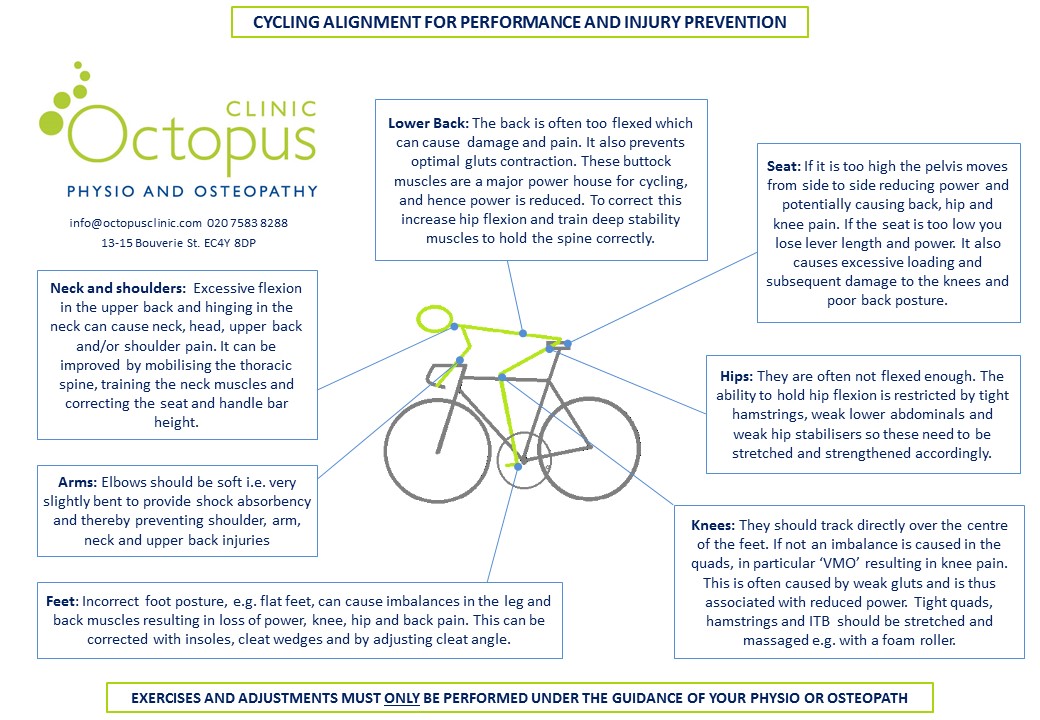Cycling
A huge number of our patients cycle either competitively or as a means of transport, we have Physiotherapists and Osteopaths that are specialists in cycling.
We provide cycling assessments so that, whether you are competing in the Etape or simply cycling to work, we know how to tweak body position and bike set up to enable recovery and improve performance.
If you have an injury you need to see an experienced Physiotherapist who will get you back on your bike ASAP.
Apart from those resulting from a fall, cycling injuries are normally as a result of:
- Incorrect body positioning or posture on the bike
- Inefficiencies in cycling technique
- Incorrect bike set up
- Weaknesses or imbalances in the muscles that enable good biking technique
- Stiffness in joints or soft tissues that prevent good bike technique
- A combination of the above
Common cycling injuries include the following.
- Pain at the front of the knee anterior knee pain which can be caused by:
- Pain at the side of the knee could be ITB friction syndrome.
- Pain in the neck or upper back could be caused by incorrect neck posture.
- Back pain, sometimes radiating into the legs could be a number of different conditions.
- Hip pain
Remember, it is important to have your pain fully assessed and treated by a Physiotherapist or Osteopath to prevent further damage occurring.
Please see below for tips on cycle set up and body positioning

-
Neck Pain/Tightness
Mild neck pain and/or tightness that comes on slowly is commonly due to the upper back rounding forwards and the chin pointing forwards and upwards, which increases muscle and nerve tension and may cause pins and needles or pain in the arms and hands. Sometimes, breathing becomes restricted due to...
Read More -
Shoulder Impingement Syndrome
This is often painful through the middle of the range of movement as you take your arm out to the side and then up to above your head. Try this test – stop as soon as you feel pain: stand with your arms out in front of you as if...
Read More -
Cervical disc injury
Cervical disc problems include degeneration, disc bulges or disc prolapses.If the discs in the neck become damaged they can bulge out and irritate or pinch the nerves coming out of the neck or the spinal cord itself. This clearly has serious implications, however can often be treated successfully with physiotherapy...
Read More -
Clicking Shoulder
Clicking or crunching in the shoulder can be caused by a number of things. Most people fear that the clicking is caused by bone hitting bone. However, thankfully nowadays this is rare. If you have this, it is likely that for many years you have been suffering severe pain and...
Read More -
Stiff Thoracic Spine
The thoracic spine – middle and upper part of the back - is the stiffest part of the spine due to the ribs attaching here, but it commonly becomes too stiff as a result of poor postures. Please click here to learn correct sitting posture. Thoracic spine stiffness puts more...
Read More -
Plantar Fascitis (pain sole of foot)
If the sole of your foot is tender to touch, particularly under the heel, and the pain came on gradually, you may have plantar fasciitis.It is often more painful first thing in the morning and can become very severe the longer you are on your feet. Plantar-fascitis is damage and...
Read More
Common Injuries
-
Foot and ankle exercises
There are a variety of exercises that are great for your feet and ankles including: 1) Foot self-massage exercise 2) Eccentric calf strengthening 3) Foot muscles strengthening 4) Concentric calf strength and ankle instability exercise
Read More -
Resisted Static Hip Flexion in Sitting
Hip flexor muscle exercise and tendon loading can be brilliant for hip flexor tendon pain but must only be done under the guidance of your Physiotherapist. Please email reception@octopusclinic.com to book now. https://youtu.be/f9wYTHV2g7s
Read More -
Glut/ VMO/ leg alignment exercise
Please click here to read 'how the knee works' before reading the following. This exercise trains the lateral glute muscle fibres, lower limb alignment, VMO (the inside part of the quads muscle) and stretches the calf so is a big hitter – if you can get it right! You will...
Read More -
Correct your neck posture
Please read how the neck works before reading the following. The effect of gravity on the head is that it moves down and forwards, away from the body. As a result of the head being lowered it then has to be rotated upwards in order to look straight forwards not...
Read More -
Stretching
A note on static stretching v dynamic stretching I bet you can't remember the last time you saw elite athletes doing a static stretches pitch-, track- or court side pre-performance. That is because research now shows that static stretching is not advisable before exercise. This is because it slows...
Read More -
Shoulder exercises
There are a variety of exercises that are great for your shoulders including: 1) Train shoulder posture 2) Train your scapular stabilizers 3) Train serratus anterior muscle 4) Stretch the lats (latissimus dorsi) muscles 5) Train the rotator cuff muscles
Read More
Exercises
Related News
-
Should you worry about your clicking joints? What is causing...
Our Physiotherapist gives you the answers you need in...
Read More -
Can you lift your testicles? Training the pelvic floor for...
As a physiotherapist I use that first sentence surprisingly frequently....
Read More -
Good physio vs bad physio: how you can tell
'Physio failed' My heart sinks and I want to...
Read More -
Is your problem our specialism? Our physios and osteopaths describe...
Do you want to make sure your problem is...
Read More